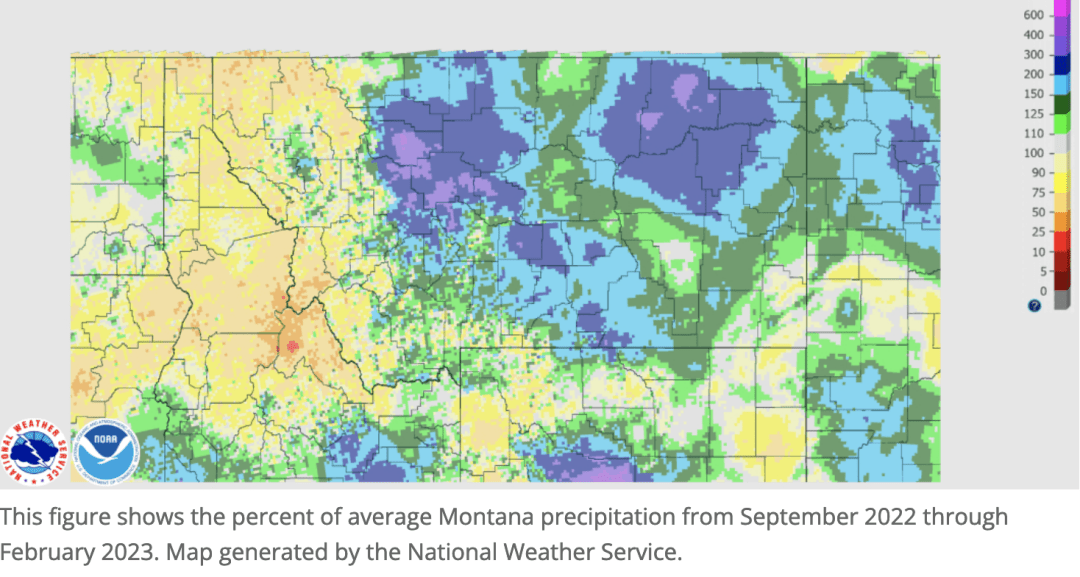Montana State University Extension shares weather-based spring fertilizer adjustments
Monday Mar. 27th, 2023

BOZEMAN — A Montana State University Extension soil fertility specialist suggests considering spring soil water content and temperatures when making fertilizer decisions for the upcoming growing season.
According to Clain Jones, MSU Extension soil fertility specialist and a professor in the Department of Land Resources and Environmental Sciences, many parts of Montana east of the Continental Divide received above-average precipitation from September 2022 through February 2023, including the Golden Triangle, which received at least twice the normal precipitation.
“Paired with below-average temperatures, fields will likely be cold and wet this spring, and planting could be delayed,” Jones said.
Jones noted that cold and wet conditions can impact soil nutrients.
“Cool temperatures decrease crop residue decomposition and the conversion of urea or ammonium fertilizers to plant-available nitrogen. High precipitation can leach nutrients, like nitrogen, sulfur and chloride, through the soil. Waterlogged soils also increase nitrogen loss as gas, decrease plant nutrient uptake due to poor root growth and increase disease pressure,” he said.
Weather and Yield Goals
Jones recommends that yield goals for the growing season should reflect a combination of long-term averages combined with recent weather conditions.
“If planting is significantly delayed due to cool and wet soils, yield goals may decrease, and fewer total nutrients are needed,” he said. “However, higher than normal soil moisture or growing season precipitation may increase yield goals as soil moisture is maintained through the growing season.”
Drier than average conditions, like those seen in most of western Montana and a few areas east of the divide, will also impact soil nutrient availability.
“Crops access nutrients through soil water,” Jones said. “If soil moisture is low, nutrients move more slowly through the soil, which can impact crop uptake.”
In addition, surface broadcast fertilizers depend on precipitation to move into the soil, according to Jones. For that reason, they should be applied ahead of a significant forecasted rain event.
Lastly, Jones noted that fertilizer damages seeds more when soils are dry, especially in coarse soils. He recommends working with crop advisers or Extension agents to determine seed-safe fertilizer rates.
If recent local weather has been drier than average, soil moisture may not have replenished from the previous growing season, and yield goals may decrease. Kent McVay, MSU Extension cropping systems specialist at the Southern Agricultural Research Center in Huntley, has written a MontGuide on determining yield potentials based on spring soil moisture and typical growing season precipitation. The publication is available at store.msuextension.org/Products/Water-Productivity-of-Montana-Crops-MT202204AG__MT202204AG.aspx.
Early-Season Fertilizer Applications
Providing small amounts of nitrogen, sulfur and chloride at seeding can give plants a boost when early season nutrient availability is low, according to Jones. Those nutrients move easily with soil water and so can be broadcast or applied with seed, though Jones also urged caution when applying fertilizers with the seed to avoid salt or ammonia injury to seedlings.
Phosphorus and potassium move slower when soil temperatures are low, so if soil tests suggest a field is deficient, these nutrients should be placed with, or close to, the seed, he added.
Spring soil testing can help determine if nitrogen has been lost from a field over winter. Jones recommends taking soil samples in the top 6 inches and in the 6-inch to 3-foot depth and having them analyzed for nitrate.
“Young roots will grow and reach nitrogen if it has only leached a few inches,” Jones said. “Later in the season, roots can access deeper nitrogen as well.” However, leached nitrogen may be beyond the reach of even mature roots, especially in coarse or shallow soils.
Rescue Nutrient Applications
Jones said producers or crop advisers should monitor crops in the early season for signs of nutrient deficiencies, as rescue nutrient applications can be made if deficiencies are widespread in a field.
“Nitrogen deficiency shows as uniform, yellow discoloration on lower, older leaves first. Sulfur deficiency also causes uniform yellowing but shows up on upper, younger leaves first,” Jones said.
More detailed descriptions and pictures of nutrient deficiency symptoms are available at landresources.montana.edu/soilfertility/nutrientdeficient.
Generally, Jones said, a rescue treatment for nitrogen is 10 to 20 units (pounds per acre) of nitrogen applied as 28% or 32% urea ammonium nitrate solution (3 to 6 gallons per acre). Urea ammonium nitrate provides immediately available nitrogen (nitrate and ammonium) in addition to urea, which will convert to ammonium within several days to a couple weeks of application.
A rescue treatment for sulfur is to apply three to five units of sulfur as granular ammonium sulfate (21-0-0-24) or as a liquid sulfate formulation. Jones added that ammonium sulfate is a good option when it is difficult to determine which nutrient is lacking, as it can help with both nitrogen and sulfur deficiencies.
Jones cautioned that foliar applications could cause leaf burn.
“Streamer bars minimize burn and are preferred if more than 25 units of nitrogen are applied. The risk of burn increases when herbicides, fungicides, surfactants or sulfur are included in a mix with nitrogen. In these cases, don’t exceed 15 units of nitrogen if applied with a flat fan nozzle,” Jones said. “Burn should not be an issue if nitrogen is put through a pivot because the nitrogen concentration in the irrigation water will be very low.”
Broadcast applications are best followed by a half-inch of irrigation or rainfall within a couple of days to minimize nitrogen loss as ammonia gas and to force nitrogen into the root zone, Jones said.
“This is also true for foliar applications because only a small portion is absorbed through the leaf,” he said. “The rest needs to be washed off and moved into the soil to be taken up by roots.”
Individuals can contact a crop adviser or local Extension agent for help making fertilizer decisions. Questions about soil fertility may also be directed to Jones at clainj@montana.edu or 406-994-6076 or addressed by visiting the MSU Extension soil fertility website at landresources.montana.edu/soilfertility/.
| Tweet |